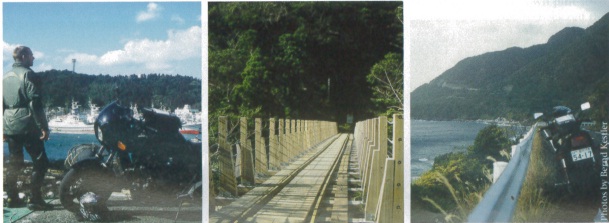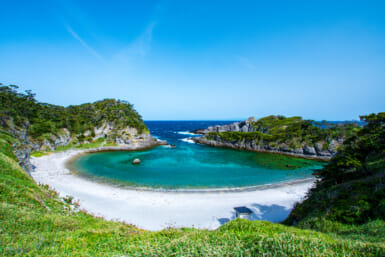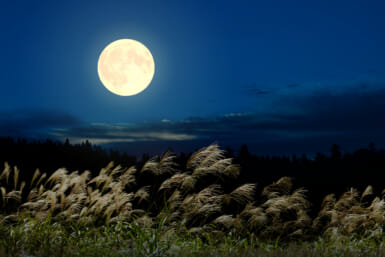by Bernd Kestler
Kyushu — an island full of history, friendly people, natural beauty and some of the best roads in the world.
For about five years I have been riding motorcycles in Japan. For almost as long I have known about a small island off Kyushu in southern Japan called Yakushima. I thought I would never get there, especially not on a motorbike. However, last year I got myself down to Kyushu for some great touring, and to see a very special 2,000 year old tree.
As I wanted to take my own black Honda CB 1000 T2 with me I had two choices: either to ride all the way down from Tokyo with me, (which probably would have taken me a full day and night on the road plus, it would have cost me a fortune in tolls) or to take the car ferry from Kawasaki to Miyazaki in the southeast of Kyushu. I chose the latter.
The ferry leaves Kawasaki in the evening and takes until late afternoon the next day to arrive in Miyazaki. During winter motorbike tourists are rare, especially foreigners. Still some bikers had the same idea and it gave me an opportunity to exchange some first-hand information about good places to go and interesting roads to ride.
A good map is absolutely essential, as roads are not clearly marked, smaller ones appear only in Japanese and sometimes two different roads have the same number. I used the motorbike-touring atlas Touring Mapple, published by Shobunsha. They publish a different book for each region of Japan, which are suitably detailed; listing good places to go to, worthwhile roads and other useful information for bikers.
The infrastructure in Japan is absolutely superb. Even the smallest roads are suitable for on-road bikes like mine. I found roads of up to 40km winding up and down in a single line through the most beautiful forests, spotlessly clean with not one hole in the pavement.
The best roads are the so-called ‘Skylines’, mostly toll-roads, but absolutely worth every yen. In Kyushu I rode the Ibusuki-Skyline, but unfortunately I went so high up into the mountains, that I encountered snow on the road and had to go back. Still I made it to Ibusu-ki to visit a sand bath, where bathers dressed in cotton yukata (light kimono), are covered with sand, warmed in the hot-spring water.
From Miyazaki, I went along the coast towards Kagoshima, visiting the Udo Shrine. For ¥100 you can buy five little clay balls to throw into a dent within a sacred rock that looks like a turtle. The turtle is a symbol of long life in Japan and if you make a wish and get the ball into the dent, your wish will come true, they say.
My route then led me to Cape Toi with its wild horses that were abandoned 300 years ago by a feudal clan and are now listed as a natural monument. Gentle hills are covered with wild fern palms, which extend further south to Cape Sata, on the 31st degree north — the same level as New Delhi (India) and New Orleans.
Later, at the Bay of Kagoshima, I came across the peninsula of Sakurajima. Once an island, a volcanic eruption in 1914 connected it permanently to the main island. From a distance Sakurajima appears to have only a single cone, but on closer inspection I found that there are actually three, one of which, the southern-most called Minamidake, is still active, spraying gray ash into the sky from time to time.
The city of Kagoshima was the starting point for me to cross over to Yakushima, the original goal of my trip. The ferry leaves at 8:45am and takes about four hours. The boat is rather small so it is vulnerable to the waves, which can result in seasickness for the whole journey. Still, once you reach the island the unpleasant experience is easily forgotten.
Yakushima is an almost perfectly round island with an area of about 500km2. Kyushu’s highest peak, Mount Miyanoura, at a height of 1,935m above sea level towers magnificently over the center of the island. The climate is subtropical; still the higher areas can be covered with snow.
From the ferry I went on to find a hotel or ryokan, a kind of inn for travelers. As it wasn’t the tourist season it didn’t take me long to find a small pension, where I could leave my luggage and go on a little round trip of Yakushima. The ring-road is about 108km long and runs along many of the must-see places, like the Oko-Waterfall, which has been selected as one of the 100 best waterfalls in Japan.
The next morning, I set off to see the tree. I rode my bike to the parking area where the footpath starts. One thing I always enjoy in Japan is the safety. I can leave my riding gear on the back of my bike secured with nothing but a rubber net, knowing that it will stay there the whole day, untouched, until I return.
The Jomon-Sugi Cedar stands right in the middle of the forest. No road, not even a paved path leads you there. To see the tree, you have to walk along an old rail-track that was once a route to get forest workers into the woods. It takes about four hours to reach the cedar. The first three hours are relatively comfortable, but the last hour is just a mud-path (and sometimes not even that) through the woods, which is hardly visible and definitely impossible to find in the dark. But the view walking through a forest of thousand year-old trees is an unforgettable experience.
Finally, I got to the Jomon-Sugi. The tree was discovered in 1966 and in 1996 Yakushima was listed as a World Heritage Site. Every year, scores of tourists come from all over Japan to see the tree, which is at least 2,100 years old, but, measured by its size, could be up to 7,200 years of age. Its trunk has a perimeter of 16.8m and about 25m high. It then took me another three hours to get back to my bike, and I found all my gear just as I had left it.









